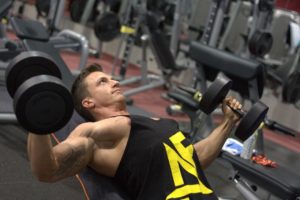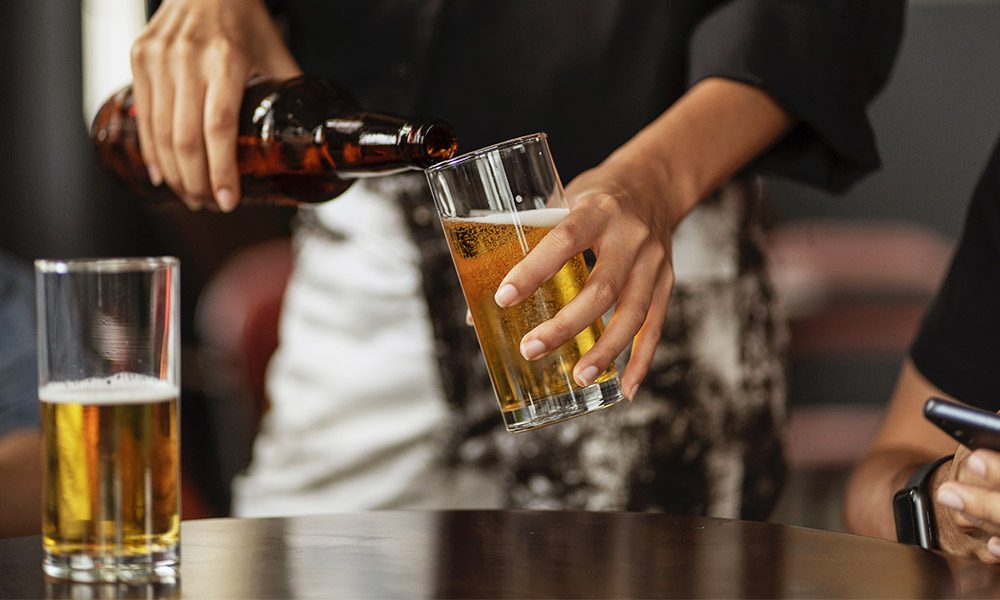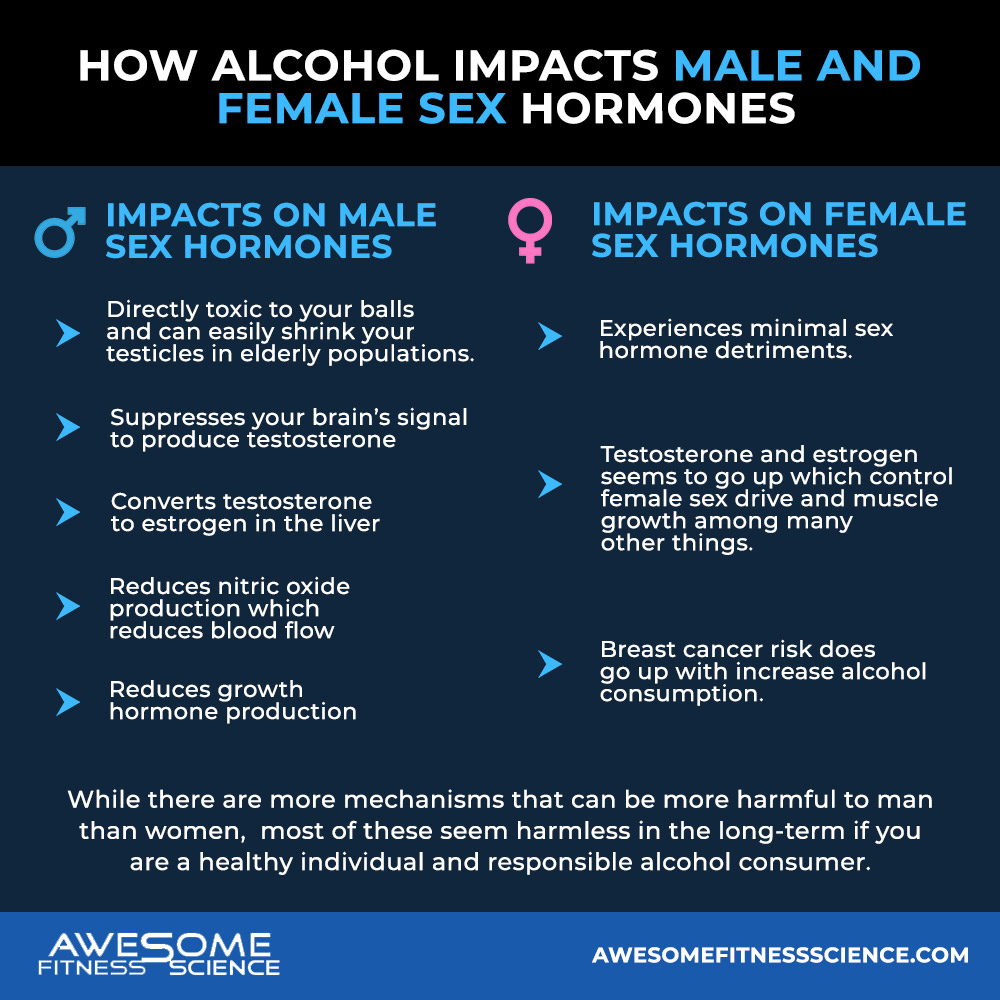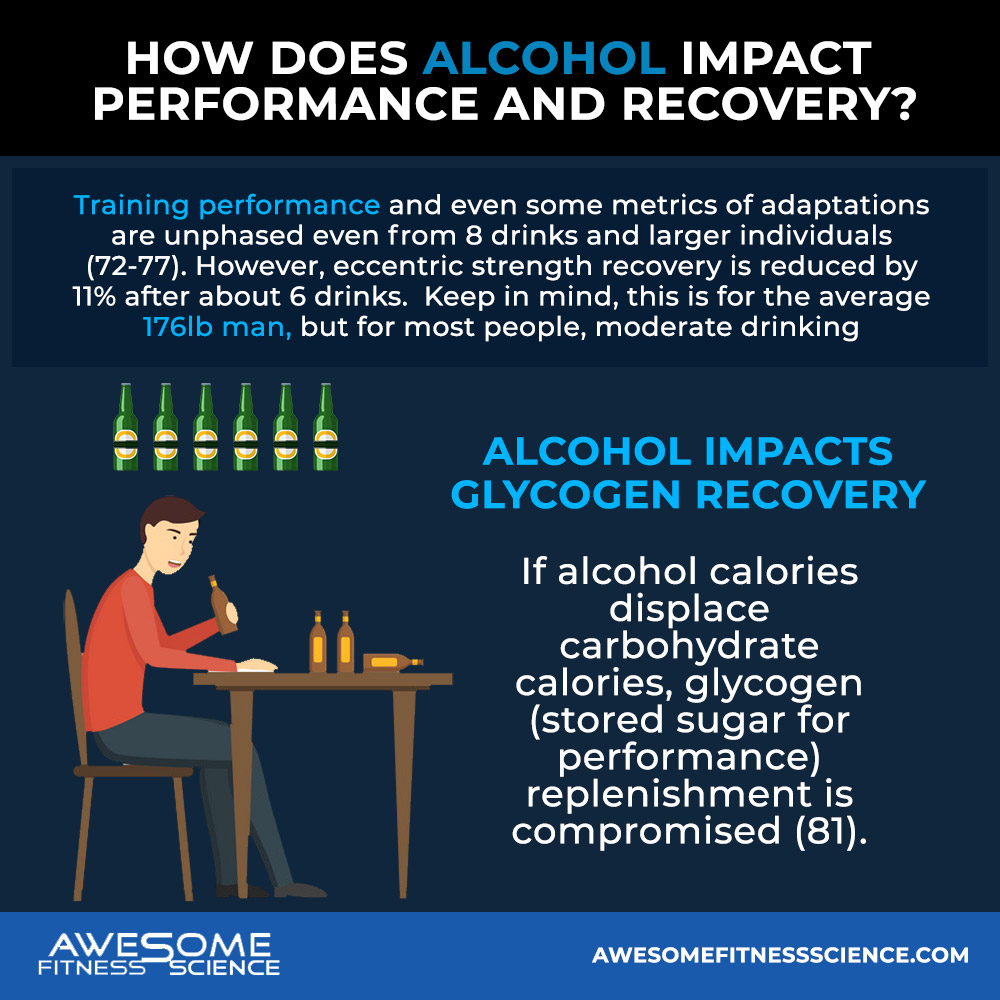
Reviewing The Best Muscle Building Training Splits
Reviewing The Best Muscle Building Training Splits Everybody thinks there’s some sort of magic in a specific training split. We got old school bodybuilders who

If there’s one thing people love, it’s alcohol. You want to drink it, but also want to be hot and healthy. Allow me to teach you about how alcohol impacts your health and physique goals.
You’ll leave here going from a level one dork who only knows how to get wasted to a sophisticated drinker who understands exactly how alcohol works in detail. Let’s get into it.
When we’re talking about alcohol, we’re really talking about ethanol which is the chemical compound that gets you tipsy. Alcohol is made when yeast digests the sugar in carb sources like grapes to make wine or grains to make beer for example.
Many people drink alcohol to take the “edge” off of life. More specifically, alcohol reduces consciousness and inhibition making people think less about troubling thoughts (1). It also makes bad dancers decent. Thus, alcohol can reduce anxiety temporarily, but also at the cost of impairing judgment (2).
By definition, alcohol is a toxin or poison in your body (9,10). Your body can’t store it which is hilarious when people say alcohol turns into fat because your body doesn’t alcohol at all.
Because of this, your body immediately uses your liver to burn it off (3).
As your liver fights off alcohol, a war is essentially waged which raises your risk of a fatty liver (4).
Fortunately, fatty liver disease is reversible, but it can be developed with as little as half an ounce daily, thus wear and tear on the liver can accumulate with frequency (5,6). Furthermore, heavy drinkers can develop cirrhosis where liver cells perish while the liver scars up into a wrinkly useless tissue (7,8). Unfortunately, Cirrhosis is irreversible.
Alcohol also impairs brain function with moderate use and can damage your brain with heavy use (12, 13). This effect is more pronounced in nutrient deficient individuals (14). Furthermore, blackouts are a sign, you’ve drank enough to negatively alter brain function (15).
If you drink chronically during older life, your brain essentially gets poisoned. It can shrink and risk of dementia can skyrocket (16-21).
Alcohol also increases blood pressure and negates/reduces some of the cardio/metabolic benefits of fat loss (22,23,24).
Because the risk outweighs any potentially minor health benefit, alcohol is not inherently healthy especially for those with poor health and pre-existing issues (11).
However, how does these risks translate to death? Most long-term research can’t isolate alcohol’s true impact because some demographics with favorable qualities like education, income, and self-control also drink (25).
When you crunch together all the studies for a risk threshold, it appears that drinking 1-2 drinks no more than 2-3 times per week puts you at lowest risk for all-cause mortality (26). Assuming you stay under 200 grams of alcohol per week, even a daily drink poses minimal risk to death, shaving off about half a year of life compared to non-drinkers (27).
However, chronically drinking more than 350 grams per week regardless of the frequency during the week can slice off at least 5 years off your life (27).
Many studies don’t control for exercise, so habitual exercisers are likely less at risk. All in all, small amounts will still have health impacts, but they likely don’t translate to anything significant if moderated in healthy individuals.
Beyond basic health, let’s see how alcohol impacts fat loss. As mentioned before, alcohol is perceived as toxic to your body. Thus, your body ceases fat burning to burn off the alcohol (28). Fat burning only returns once the alcohol is burned off. However, the fat that would’ve been burned off while alcohol burning takes place still gets stored.
Long term, alcohol can only cause net fat gain if you consume it in a caloric surplus aka an excess of total calories. However, if you burn more total calories than you store over time, you can still lose fat regardless if alcohol makes up any percentage of those calories (29,30,31). This is why anybody who understands basic physics isn’t shocked at the occasional headlines of people losing weight drinking nothing but alcohol (32).
However, what’s possible in theory isn’t so practical in the real world. Why’s that?
Well, while alcohol isn’t inherently fattening, alcohol increases your appetite. Research finds both low and high alcohol consumption increases your appetite, usually by a few hundred calories (33-36).
So the alcohol itself might not directly make you fat, but greasy bar food catching your eye can. You’ll likely end up eating more wings and mozzarella sticks than intended, especially in a social setting.
Not to mention, alcohol is a piss poor investment of calories compared to other choices if nutrients and satiety are a concern.
Grab my free checklist on how to defeat your worst food cravings
Fellas, alcohol is directly toxic to your balls and alcohol abuse can easily shrink your testicles (37,38,39). That’s not clickbait. It suppresses your brain’s signal to produce testosterone, converts testosterone to estrogen in the liver, reduces nitric oxide production which reduces blood flow, damages testicle cells, increases cortisol (stress hormone), and reduces growth hormone production (39-44). Well, that was a mouthful.
Anyways, with heavy drinking (4-8 drinks), testosterone can drop as much as 40% with recovery usually taking days (45-50).
We’ll go over how this impacts muscle growth later, but testosterone drops will impact many things for men, most notably, sexual health.
In long term studies, light drinking seems to be ok, but moderate to heavy drinking puts you at risk for erectile dysfunction (51,52). So endless beer with the boys will tank your bedroom life with the Mrs.
Alcohol attacks a man’s balls, but because women don’t have balls (ummm duh), females don’t experience sex hormone detriments.
Besides the universal health detriments to the liver and some other metrics mentioned earlier from heavy drinking, female are essentially immune hormonally. In fact, testosterone and estrogen benefit slightly from alcohol in females, both of which control female sex drive and muscle growth.
Testosterone and estrogen seems to go up with even as much as 8 drinks in females (53-62). Acutely, women can benefit hormonally from alcohol and avoid sex hormone side effects.
These effects can increase a women’s desire for sex, but at higher doses, it also reduces the experience by reducing vaginal pulse pressure and vaginal blood volume along with reducing genital pleasure (82).
Alcohol can impact the boobs as well.
Breast cancer risk follows alcohol consumption in a dose response (63,64,65). Unfortunately, research finds, many women even older women are oblivious to this risk (66).
So while females clearly have less to lose hormonally from alcohol, there are still relevant reasons women should still monitor their alcohol intake.

Because testosterone signals for the muscle growth pathway, alcohol blunts hypertrophy (67,68,69). Muscle protein synthesis (MPS) rates drops more in men than women (70).
MPS drops by 37% post workout with alcohol alone. You can salvage this a bit by having protein alongside alcohol, but MPS will still drop by 24% after about 9 drinks (71).
So heavier drinking seems to be detrimental and can negate some muscle growth in men.
Should you hit the gym after a night of drinking? Probably. Your performance will likely be fine as long as you’re not hungover. Training performance and even some metrics of adaptations are unphased even from 8 drinks in larger men (72-77).
One study did found 6 drinks reduced eccentric strength recovery by 11%, so there is likely some recovery risk when you’re drinking moderate to heavy amounts (78).
Furthermore, if alcohol calories displace carbohydrate calories, glycogen (stored sugar for performance) replenishment is compromised (81).
So while the short term effects of alcohol on recovery/performance are minimal to non-existent, there is likely a long term detriment due to higher cortisol, lower testosterone, lower protein signaling, compromised glycogen stores, dehydration, and worst sleep quality (72,73).

Alcohol poses some degree of risk. I think there is merit to limiting it and even going through seasons without it like dry January. However, many people want to strike a balance between being able to drink and still being relatively healthy. For fitness enthusiasts, they also want to drink while building muscle or losing fat.
So here are some basic guidelines to do so:
Here’s a cute graphic for any macro trackers to ensure you’re tracking alcohol correctly. It’s easier than most people think.

Furthermore, below are some low calorie drinks you can opt for if you’re trying to get/stay lean.
· Vodka soda – 133 calories in a 7.5-ounce (225-mL) serving
· White wine – 123 calories in each 5-ounce (150-ml) serving
· Hard seltzer – 99 calories in 12-ounce (355-mL) serving
· Tequila with lime – (42 mL) of tequila with a lime wedge has only 99 calories in total
· Light beer – 12-ounce (360-mL) can of light beer usually has about 104 calories
· Gin and diet tonic – 2 ounces (56 mL) of gin and 4 ounces (118 mL) of diet tonic water provides 128 calories
· Dry martini – 2.5 ounces (70 mL) of gin and 0.5 ounces (15 mL) of vermouth contains 185 calories
· Paloma – 169 calories, mix 1.5 ounces (42 mL) of tequila with 6 ounces (186 mL) of grapefruit juice, some ice, and a bit of lime juice
· Rum and Diet Coke – 7.5-ounce (225-mL) serving of rum and Diet Coke contains 135 calories
· Mojito minus the syrup – contain about 168 calories
· Light bloody mary – Premixed or packaged versions can range anywhere from 200 to 400 calories
· Light beer – Light beers tend to be around 50 calories less than regular brews.
· Rosé – 120 kcal
· Champagne – 90-96 kcal
· White wine – 121 kcal
· Kombucha with vodka – 90 kcal
· Red wine – 125 kcal
· Hot toddy – Less than 150 kcal
The topic of how alcohol impacts general health, male health, female health, fat loss, muscle growth, performance, and recovery are super nuanced. I’m too lazy to summarize everything, but in general if you’re a healthy individual, light or even moderate drinking occasionally isn’t that big of a deal.
So cheers to being able to have your wine and drinking it too.
1.
RA;, Steele. “Alcohol Myopia. Its Prized and Dangerous
Effects.” The American Psychologist, U.S. National Library of Medicine,
https://pubmed.ncbi.nlm.nih.gov/2221564/.
2.
Rothman . “Does the Alcohol Make Them Do It? Dating
Violence Perpetration and Drinking among Youth.” Epidemiologic Reviews,
U.S. National Library of Medicine, https://pubmed.ncbi.nlm.nih.gov/22128086/.
3.
AI;, Cederbaum. “Alcohol Metabolism.” Clinics in
Liver Disease, U.S. National Library of Medicine,
https://pubmed.ncbi.nlm.nih.gov/23101976/.
4.
GE;, Massey. “Acute Alcohol-Induced Liver Injury.” Frontiers
in Physiology, U.S. National Library of Medicine,
https://pubmed.ncbi.nlm.nih.gov/22701432/.
5.
DW;, Crabb. “Pathogenesis of Alcoholic Liver Disease:
Newer Mechanisms of Injury.” The Keio Journal of Medicine, U.S. National
Library of Medicine, https://pubmed.ncbi.nlm.nih.gov/10638142/.
6.
GE;, Bergheim. “Treatment of Alcoholic Liver Disease.” Digestive
Diseases (Basel, Switzerland), U.S. National Library of Medicine,
https://pubmed.ncbi.nlm.nih.gov/16508292/.
7.
Rivara. “The Magnitude of Acute and Chronic Alcohol
Abuse in Trauma Patients.” Archives of Surgery (Chicago, Ill. : 1960),
U.S. National Library of Medicine, https://pubmed.ncbi.nlm.nih.gov/8102049/.
8.
Barrio. “Liver Disease in Heavy Drinkers with and
without Alcohol Withdrawal Syndrome.” Alcoholism, Clinical and Experimental
Research, U.S. National Library of Medicine,
https://pubmed.ncbi.nlm.nih.gov/14745311/.
9.
Rohsenow . “Intoxication with Bourbon versus Vodka:
Effects on Hangover, Sleep, and next-Day Neurocognitive Performance in Young
Adults.” Alcoholism, Clinical and Experimental Research, U.S. National
Library of Medicine, https://pubmed.ncbi.nlm.nih.gov/20028364/.
10. WE;,
Schroeder. “Effects of Congener and Noncongener Alcoholic Beverages on a
Clinical Ataxia Test Battery.” Aviation, Space, and Environmental Medicine,
U.S. National Library of Medicine, https://pubmed.ncbi.nlm.nih.gov/496757/.
11. Chiva-Blanch,
Gemma, and Lina Badimon. “Benefits and Risks of Moderate Alcohol Consumption on
Cardiovascular Disease: Current Findings and Controversies.” Nutrients,
MDPI, 30 Dec. 2019, https://www.ncbi.nlm.nih.gov/pmc/articles/PMC7020057/.
12. CG;,
Zah. “Clinical and Pathological Features of Alcohol-Related Brain Damage.” Nature
Reviews. Neurology, U.S. National Library of Medicine,
https://pubmed.ncbi.nlm.nih.gov/21487421/.
13. DR;,
Read. “Predicting Functional Outcomes among College Drinkers: Reliability and
Predictive Validity of the Young Adult Alcohol Consequences Questionnaire.” Addictive
Behaviors, U.S. National Library of Medicine,
https://pubmed.ncbi.nlm.nih.gov/17706888/.
14. C;,
Harper. “The Neuropathology of Alcohol-Related Brain Damage.” Alcohol and
Alcoholism (Oxford, Oxfordshire), U.S. National Library of Medicine,
https://pubmed.ncbi.nlm.nih.gov/19147798/.
15. DJ;,
Lee. “Alcohol-Induced Blackout.” International Journal of Environmental Research
and Public Health, U.S. National Library of Medicine,
https://pubmed.ncbi.nlm.nih.gov/20049223/.
16. MN;,
Verbaten. “Chronic Effects of Low to Moderate Alcohol Consumption on Structural
and Functional Properties of the Brain: Beneficial or Not?” Human
Psychopharmacology, U.S. National Library of Medicine,
https://pubmed.ncbi.nlm.nih.gov/19330800/.
17. Zuccalà.
“Dose-Related Impact of Alcohol Consumption on Cognitive Function in Advanced
Age: Results of a Multicenter Survey.” Alcoholism, Clinical and Experimental
Research, U.S. National Library of Medicine,
https://pubmed.ncbi.nlm.nih.gov/11781507/.
18. Ding
. “Alcohol Intake and Cerebral Abnormalities on Magnetic Resonance Imaging in a
Community-Based Population of Middle-Aged Adults: The Atherosclerosis Risk in
Communities (ARIC) Study.” Stroke, U.S. National Library of Medicine,
https://pubmed.ncbi.nlm.nih.gov/14657449/.
19. Mukamal.
“Alcohol Consumption and Subclinical Findings on Magnetic Resonance Imaging of
the Brain in Older Adults: The Cardiovascular Health Study.” Stroke,
U.S. National Library of Medicine, https://pubmed.ncbi.nlm.nih.gov/11546878/.
20. Mukamal.
“Prospective Study of Alcohol Consumption and Risk of Dementia in Older
Adults.” JAMA, U.S. National Library of Medicine,
https://pubmed.ncbi.nlm.nih.gov/12636463/.
21. JC;,
Brust. “Ethanol and Cognition: Indirect Effects, Neurotoxicity and
Neuroprotection: A Review.” International Journal of Environmental Research
and Public Health, U.S. National Library of Medicine,
https://pubmed.ncbi.nlm.nih.gov/20617045/.
22. IL;,
Puddey. “A Randomized Controlled Trial of the Effect of Alcohol Consumption on
Blood Pressure.” Clinical and Experimental Pharmacology & Physiology,
U.S. National Library of Medicine, https://pubmed.ncbi.nlm.nih.gov/4028514/.
23. Xin.
“Effects of Alcohol Reduction on Blood Pressure: A Meta-Analysis of Randomized
Controlled Trials.” Hypertension (Dallas, Tex. : 1979), U.S. National
Library of Medicine, https://pubmed.ncbi.nlm.nih.gov/11711507/.
24. Apolzan,
John W., et al. “The Effects of Alcohol Consumption on Cardiometabolic Health
Outcomes Following Weight Loss in Premenopausal Women with Obesity: A Pilot
Randomized Controlled Trial.” MDPI, Multidisciplinary Digital Publishing
Institute, 23 July 2020, https://www.mdpi.com/1660-4601/17/15/5302.
25. Correlates
of Alcoholic Beverage Preference: Traits of …
https://onlinelibrary.wiley.com/doi/pdf/10.1111/j.1360-0443.1990.tb01604.x.
26. Hartz.
“Daily Drinking Is Associated with Increased Mortality.” Alcoholism,
Clinical and Experimental Research, U.S. National Library of Medicine,
https://pubmed.ncbi.nlm.nih.gov/30281161/.
27. Wood,
Angela M, et al. “Risk Thresholds for Alcohol Consumption: Combined Analysis of
Individual-Participant Data for 599 912 Current Drinkers in 83 Prospective
Studies.” Lancet (London, England), Elsevier, 14 Apr. 2018,
https://www.ncbi.nlm.nih.gov/pmc/articles/PMC5899998/.
28. Sonko.
“Effect of Alcohol on Postmeal Fat Storage.” The American Journal of
Clinical Nutrition, U.S. National Library of Medicine,
https://pubmed.ncbi.nlm.nih.gov/8116538/.
29. MJ;,
Cordain. “Influence of Moderate Daily Wine Consumption on Body Weight
Regulation and Metabolism in Healthy Free-Living Males.” Journal of the
American College of Nutrition, U.S. National Library of Medicine,
https://pubmed.ncbi.nlm.nih.gov/9100213/.
30. Cordain.
“Influence of Moderate Chronic Wine Consumption on Insulin Sensitivity and
Other Correlates of Syndrome x in Moderately Obese Women.” Metabolism:
Clinical and Experimental, U.S. National Library of Medicine,
https://pubmed.ncbi.nlm.nih.gov/11092514/.
31. Flechtner.
“Effects of Moderate Consumption of White Wine on Weight Loss in Overweight and
Obese Subjects.” International Journal of Obesity and Related Metabolic
Disorders : Journal of the International Association for the Study of Obesity,
U.S. National Library of Medicine, https://pubmed.ncbi.nlm.nih.gov/15356671/.
32. CBS
Pittsburgh. “Ohio Man Loses More than 30 Pounds Drinking Only Beer during
Lent.” CBS Pittsburgh, CBS Pittsburgh, 5 Apr. 2019,
https://pittsburgh.cbslocal.com/2019/04/05/ohio-man-drinking-only-beer-for-lent-losing-weight/.
33. LM;,
Hetherington. “Stimulation of Appetite by Alcohol.” Physiology &
Behavior, U.S. National Library of Medicine, https://pubmed.ncbi.nlm.nih.gov/11714490/.
34. MM;,
Caton. “Dose-Dependent Effects of Alcohol on Appetite and Food Intake.” Physiology
& Behavior, U.S. National Library of Medicine,
https://pubmed.ncbi.nlm.nih.gov/15059684/.
35. Kwok
. “Effect of Alcohol Consumption on Food Energy Intake: A Systematic Review and
Meta-Analysis.” The British Journal of Nutrition, U.S. National Library
of Medicine, https://pubmed.ncbi.nlm.nih.gov/30630543/.
36. MR;,
Yeomans. “Short Term Effects of Alcohol on Appetite in Humans. Effects of
Context and Restrained Eating.” Appetite, U.S. National Library of
Medicine, https://pubmed.ncbi.nlm.nih.gov/20851724/.
37. R;,
Van. “The Effect of Chronic Alcohol Abuse on Sexual Function.” Clinics in
Endocrinology and Metabolism, U.S. National Library of Medicine,
https://pubmed.ncbi.nlm.nih.gov/389488/.
38. Van
. “Alcohol-Induced Testicular Atrophy. an Experimental Model for Hypogonadism
Occurring in Chronic Alcoholic Men.” Gastroenterology, U.S. National
Library of Medicine, https://pubmed.ncbi.nlm.nih.gov/1171045/.
39. “Alcohol
and the Male Reproductive System.” National Institute on Alcohol Abuse and
Alcoholism, U.S. Department of Health and Human Services,
https://pubs.niaaa.nih.gov/publications/arh25-4/282-287.htm.
40. DM;,
Maneesh. “Alcohol Abuse-Duration Dependent Decrease in Plasma Testosterone and
Antioxidants in Males.” Indian Journal of Physiology and Pharmacology,
U.S. National Library of Medicine, https://pubmed.ncbi.nlm.nih.gov/17193902/.
41. RD;,
Cicero. “Effects of Ethanol on the Hypothalamic-Pituitary-Luteinizing Hormone
Axis and Testicular Steroidogenesis.” The Journal of Pharmacology and
Experimental Therapeutics, U.S. National Library of Medicine,
https://pubmed.ncbi.nlm.nih.gov/368312/.
42. KW;,
Chung. “Effects of Chronic Ethanol Intake on Aromatization of Androgens and
Concentration of Estrogen and Androgen Receptors in Rat Liver.” Toxicology,
U.S. National Library of Medicine, https://pubmed.ncbi.nlm.nih.gov/2389244/.
43. V;,
Purohit. “Can Alcohol Promote Aromatization of Androgens to Estrogens? A
Review.” Alcohol (Fayetteville, N.Y.), U.S. National Library of
Medicine, https://pubmed.ncbi.nlm.nih.gov/11163119/.
44. R;,
Välimäki. “The Pulsatile Secretion of Gonadotropins and Growth Hormone, and the
Biological Activity of Luteinizing Hormone in Men Acutely Intoxicated with
Ethanol.” Alcoholism, Clinical and Experimental Research, U.S. National
Library of Medicine, https://pubmed.ncbi.nlm.nih.gov/2128439/.
45. J;,
Mendelson. “Effects of Acute Alcohol Intake on Pituitary-Gonadal Hormones in
Normal Human Males.” The Journal of Pharmacology and Experimental
Therapeutics, U.S. National Library of Medicine,
https://pubmed.ncbi.nlm.nih.gov/894528/.
46. VA;,
Vatsalya. “Pharmacodynamic Effects of Intravenous Alcohol on Hepatic and
Gonadal Hormones: Influence of Age and Sex.” Alcoholism, Clinical and Experimental
Research, U.S. National Library of Medicine,
https://pubmed.ncbi.nlm.nih.gov/21797891/.
47. A;,
Vingren. “Postresistance Exercise Ethanol Ingestion and Acute Testosterone
Bioavailability.” Medicine and Science in Sports and Exercise, U.S.
National Library of Medicine, https://pubmed.ncbi.nlm.nih.gov/23470309/.
48. SR;,
Barnes. “The Effects of Acute Alcohol Consumption on Recovery from a Simulated
Rugby Match.” Journal of Sports Sciences, U.S. National Library of
Medicine, https://pubmed.ncbi.nlm.nih.gov/22168345/.
49. Murphy
. “The Effect of Post-Match Alcohol Ingestion on Recovery from Competitive
Rugby League Matches.” Journal of Strength and Conditioning Research,
U.S. National Library of Medicine, https://pubmed.ncbi.nlm.nih.gov/22836602/.
50. G;,
Haugvad. “Ethanol Does Not Delay Muscle Recovery but Decreases
Testosterone/Cortisol Ratio.” Medicine and Science in Sports and Exercise,
U.S. National Library of Medicine, https://pubmed.ncbi.nlm.nih.gov/24658221/.
51. Arackal,
Bijil Simon, and Vivek Benegal. “Prevalence of Sexual Dysfunction in Male
Subjects with Alcohol Dependence.” Indian Journal of Psychiatry, Medknow
Publications, Apr. 2007, https://www.ncbi.nlm.nih.gov/pmc/articles/PMC2917074/.
52. Wang.
“Alcohol Intake and Risk of Erectile Dysfunction: A Dose-Response Meta-Analysis
of Observational Studies.” International Journal of Impotence Research,
U.S. National Library of Medicine, https://pubmed.ncbi.nlm.nih.gov/30232467/.
53. Rinaldi.
“Relationship of Alcohol Intake and Sex Steroid Concentrations in Blood in Pre-
and Post-Menopausal Women: The European Prospective Investigation Into Cancer
and Nutrition.” Cancer Causes & Control : CCC, U.S. National Library
of Medicine, https://pubmed.ncbi.nlm.nih.gov/16933054/.
54. Hirko.
“Alcohol Consumption in Relation to Plasma Sex Hormones, Prolactin, and Sex
Hormone-Binding Globulin in Premenopausal Women.” Cancer Epidemiology,
Biomarkers & Prevention : a Publication of the American Association for
Cancer Research, Cosponsored by the American Society of Preventive Oncology,
U.S. National Library of Medicine, https://pubmed.ncbi.nlm.nih.gov/25281368/.
55. García-Closas
. “Relationship between Serum Hormone Concentrations, Reproductive History,
Alcohol Consumption and Genetic Polymorphisms in Pre-Menopausal Women.” International
Journal of Cancer, U.S. National Library of Medicine,
https://pubmed.ncbi.nlm.nih.gov/12385014/.
56. Muti.
“Alcohol Consumption and Total Estradiol in Premenopausal Women.” Cancer
Epidemiology, Biomarkers & Prevention : a Publication of the American
Association for Cancer Research, Cosponsored by the American Society of
Preventive Oncology, U.S. National Library of Medicine,
https://pubmed.ncbi.nlm.nih.gov/9521430/.
57. Vatsalya,
Vatsalya, et al. “Pharmacodynamic Effects of Intravenous Alcohol on Hepatic and
Gonadal Hormones: Influence of Age and Sex.” Alcoholism, Clinical and
Experimental Research, U.S. National Library of Medicine, Feb. 2012,
https://www.ncbi.nlm.nih.gov/pmc/articles/PMC3258349/.
58. R;,
Välimäki. “Acute Effects of Alcohol on Female Sex Hormones.” Alcoholism,
Clinical and Experimental Research, U.S. National Library of Medicine,
https://pubmed.ncbi.nlm.nih.gov/6414328/.
59. Mendelson.
“Alcohol Effects on Naloxone-Stimulated Luteinizing Hormone, Prolactin and
Estradiol in Women.” Journal of Studies on Alcohol, U.S. National
Library of Medicine, https://pubmed.ncbi.nlm.nih.gov/3613578/.
60. Mendelson,
Jack H., et al. “Acute Alcohol Effects on Plasma Estradiol Levels in Women –
Psychopharmacology.” SpringerLink, Springer-Verlag,
https://link.springer.com/article/10.1007/BF00212838.
61. Teoh.
“Alcohol Effects on HCG-Stimulated Gonadal Hormones in Women.” The Journal
of Pharmacology and Experimental Therapeutics, U.S. National Library of
Medicine, https://pubmed.ncbi.nlm.nih.gov/2117066/.
62. V;,
Purohit. “Moderate Alcohol Consumption and Estrogen Levels in Postmenopausal
Women: A Review.” Alcoholism, Clinical and Experimental Research, U.S.
National Library of Medicine, https://pubmed.ncbi.nlm.nih.gov/9726268/.
63. J;,
Shield. “Alcohol Use and Breast Cancer: A Critical Review.” Alcoholism,
Clinical and Experimental Research, U.S. National Library of Medicine,
https://pubmed.ncbi.nlm.nih.gov/27130687/.
64. Freudenheim,
Jo L. “Alcohol’s Effects on Breast Cancer in Women.” Alcohol Research :
Current Reviews, National Institute on Alcohol Abuse and Alcoholism, 18
June 2020, https://www.ncbi.nlm.nih.gov/pmc/articles/PMC7295577/.
65. Liu,
Ying, et al. “Links between Alcohol Consumption and Breast Cancer: A Look at
the Evidence.” Women’s Health (London, England), U.S. National Library
of Medicine, Jan. 2015, https://www.ncbi.nlm.nih.gov/pmc/articles/PMC4299758/.
66. Khushalani,
Jaya S, et al. “Awareness of Breast Cancer Risk Related to a Positive Family
History and Alcohol Consumption among Women Aged 15-44 Years in United
States.” Preventive Medicine Reports, U.S. National Library of Medicine,
9 Dec. 2019, https://www.ncbi.nlm.nih.gov/pmc/articles/PMC6926360/.
67. Basualto.
“Testosterone Signals through MTOR and Androgen Receptor to Induce Muscle
Hypertrophy.” Medicine and Science in Sports and Exercise, U.S. National
Library of Medicine, https://pubmed.ncbi.nlm.nih.gov/23470307/.
68. White
. “Testosterone Regulation of AKT/mtorc1/FOXO3A Signaling in Skeletal Muscle.” Molecular
and Cellular Endocrinology, U.S. National Library of Medicine,
https://pubmed.ncbi.nlm.nih.gov/23116773/.
69. Lang
. “Alcohol Impairs Leucine-Mediated Phosphorylation of 4E-BP1, S6K1, EIF4G, and
Mtor in Skeletal Muscle.” American Journal of Physiology. Endocrinology and
Metabolism, U.S. National Library of Medicine,
https://pubmed.ncbi.nlm.nih.gov/12944322/.
70. Duplanty.
“Effect of Acute Alcohol Ingestion on Resistance Exercise-Induced mtorc1
Signaling in Human Muscle.” Journal of Strength and Conditioning Research,
U.S. National Library of Medicine, https://pubmed.ncbi.nlm.nih.gov/27135475/.
71. Parr,
Evelyn B, et al. “Alcohol Ingestion Impairs Maximal Post-Exercise Rates of
Myofibrillar Protein Synthesis Following a Single Bout of Concurrent Training.”
PloS One, Public Library of Science, 12 Feb. 2014,
https://www.ncbi.nlm.nih.gov/pmc/articles/PMC3922864/.
72. Lakićević,
Nemanja. “The Effects of Alcohol Consumption on Recovery Following Resistance
Exercise: A Systematic Review.” MDPI, Multidisciplinary Digital
Publishing Institute, 26 June 2019, https://www.mdpi.com/2411-5142/4/3/41/htm.
73. G;,
Haugvad. “Ethanol Does Not Delay Muscle Recovery but Decreases
Testosterone/Cortisol Ratio.” Medicine and Science in Sports and Exercise,
U.S. National Library of Medicine, https://pubmed.ncbi.nlm.nih.gov/24658221/.
74. Levitt
. “Alcohol after Resistance Exercise Does Not Affect Muscle Power Recovery.” Journal
of Strength and Conditioning Research, U.S. National Library of Medicine,
https://pubmed.ncbi.nlm.nih.gov/29385007/.
75. Steiner,
Jennifer L., et al. “Moderate Alcohol Consumption Does Not Impair
Overload‐Induced Muscle Hypertrophy and Protein Synthesis.” The
Physiological Society, John Wiley & Sons, Ltd, 16 Mar. 2015,
https://physoc.onlinelibrary.wiley.com/doi/full/10.14814/phy2.12333.
76. Molina.
“Influence of Daily Beer or Ethanol Consumption on Physical Fitness in Response
to a High-Intensity Interval Training Program. the Beer-HIIT Study.” Journal
of the International Society of Sports Nutrition, U.S. National Library of
Medicine, https://pubmed.ncbi.nlm.nih.gov/32460793/.
77. SR;,
Barnes. “A Low Dose of Alcohol Does Not Impact Skeletal Muscle Performance
after Exercise-Induced Muscle Damage.” European Journal of Applied
Physiology, U.S. National Library of Medicine,
https://pubmed.ncbi.nlm.nih.gov/20878178/.
78. SR;,
Barnes. “Post-Exercise Alcohol Ingestion Exacerbates Eccentric-Exercise Induced
Losses in Performance.” European Journal of Applied Physiology, U.S.
National Library of Medicine, https://pubmed.ncbi.nlm.nih.gov/20012446/.
79. PB;,
Ebrahim. “Alcohol and Sleep i: Effects on Normal Sleep.” Alcoholism,
Clinical and Experimental Research, U.S. National Library of Medicine,
https://pubmed.ncbi.nlm.nih.gov/23347102/.
80. KG;,
Tracy. “The Relationship between Sleep and Physical Activity: The Moderating
Role of Daily Alcohol Consumption.” Sleep, U.S. National Library of
Medicine, https://pubmed.ncbi.nlm.nih.gov/34009345/.
81. Burke
. “Effect of Alcohol Intake on Muscle Glycogen Storage after Prolonged
Exercise.” Journal of Applied Physiology (Bethesda, Md. : 1985), U.S.
National Library of Medicine, https://pubmed.ncbi.nlm.nih.gov/12740311/.
82.
George, William H, et al. “Women’s Sexual Arousal: Effects of High Alcohol Dosages and Self-Control Instructions.” Hormones and Behavior, U.S. National Library of Medicine, May 2011, https://www.ncbi.nlm.nih.gov/labs/pmc/articles/PMC3159513/.
Grab my free Stupid Simple Scroll to Mastering Hypertrophy

Reviewing The Best Muscle Building Training Splits Everybody thinks there’s some sort of magic in a specific training split. We got old school bodybuilders who

The Lifter’s Guide to Warming Up Warming up is like saving for retirement. We all know it’s important, but we don’t exactly know why or

We all want to burn a ton of calories cause the more we burn, the more we can eat at a given energy balance. For example, it’s far better to diet on 1800 calories instead of 1200 calories.